

| June 24, 2018 | Catherine sitting near the most northern tip of Australia's mainland. |
|

| June 24, 2018 | We made it, by land and by sea. (And a huge thanks to our new 4x4 mates, Frank and Wendy, for making the land trip possible!) |
|

|
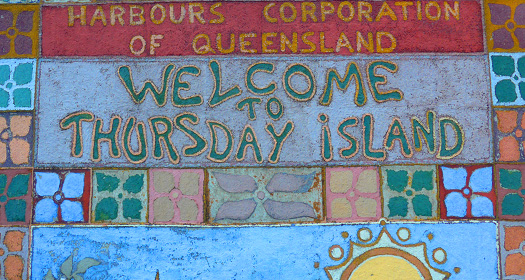
|
June 22, 2018 (Day 4,040)
Quick Fix: 10° 50.9 S / 142° 21.7 E
Conditions: Wind: 20-25/SE Sky: Mostly clear

Thursday on Friday
The history is a little fuzzy on whether it was Captain Bligh who named Thursday Island in the Torres Straits, and the neighboring islands of Wednesday and Friday, or Captain Stanley, but either way we arrived on Thursday Island today, Friday, and spent a little time exploring this remote Australian outpost, which measures only 1.4 square miles in size. While tiny, TI has an impressive multicultural history, it was settled by Melanesians almost 3,000 years ago, was once the center of a thriving pearling industry with a large community of Japanese divers, and in the late 1800's, Battery Point was constructed to defend against a Russian invasion! Today the island is invaded daily, during the dry season at least, by hordes of 4x4 enthusiasts that, after reaching the tip, want to go even further, which means a 1 hour ferry ride from the mainland. I toasted our arrival with a Great Northern beer at Australia's most northerly pub. |
|

|
 |

| June 22, 2018 | Thursday Island, Torres Straits - A gun that has never been fired in anger. |
|

|
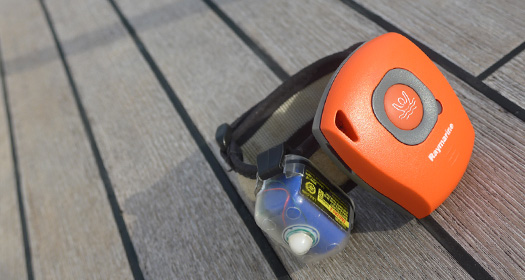
|
June 21, 2018 (Day 4,039)
Quick Fix: 10° 50.9 S / 142° 21.7 E
Conditions: Wind: 20/SE Sky: Partly cloudy

Safe Sailing
For a cruising couple there's nothing more frightening than the prospect of a Man Over Board scenario. Waking up to find an empty cockpit and your dory mate nowhere onboard, well, it's enough to keep you up at night. So years ago, after too many restless watches, we bought Raymarine Lifetags, a clever little transponder unit you wear on your wrist which activates a high-pitched alarm inside the boat should you stray more than 40 feet from the receiver. In over 36,000 nautical miles of cruising the MOB alarm has only been activated twice - once when I was recording dolphins hanging off the bow sailing to Fiji, and more recently when Catherine was adjusting the cutter boom preventer. It's fair to say that we scared the crap out of each other on both occasions! (And that now we're even) We've also just included a nifty little water-activated strobe light to the strap. We're heading up into Indonesia next month, so it's better to be safe than sorry. |
|

|
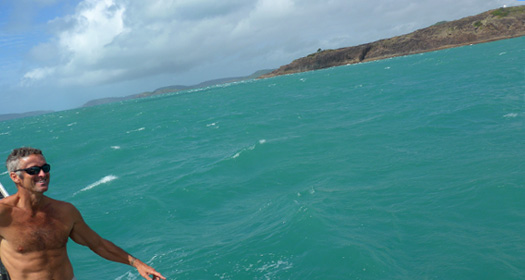
|
June 19, 2018 (Day 4,037)
Quick Fix: 10° 50.9 S / 142° 21.7 E
Conditions: Wind: 25/SE Sky: Cloudy

The Tip at The Top
It may not look very impressive, but that land you see in the photo is actually the most northern point of mainland Australia, and two days ago, with wind gusting over 30 knots and a favorable current through the Torres Straits, Dream Time raced around the summit at 10 knots SOG. We've spent the last few weeks cruising the northeastern coastline, a wild and remote area of the country with no towns or communication. A few days ago we even woke to find a crocodile sunbathing on a sandbar next to our boat. (Kite surfing and spearfishing activities have been suspended until further notice.) We're now in Seisia, a tiny Aboriginal community on the western side of Cape York, population 204. But it's the dry season now and convoys of dusty military-grade 4x4s are navigating the rough roads to reach The Tip, a high-ranking bucket list item for adventure seeking Australians, so we're not alone up here. But we are the only yacht. |
|

|
| |

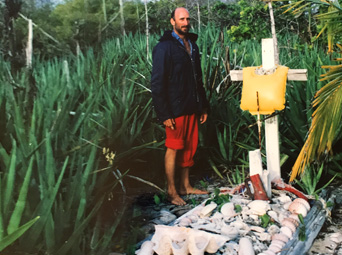
|
|
|
 |
Day 4,033 - Morris Island, Australia
17:12hrs - June 15, 2018
A Grave Site |

Twenty four years ago, whilst crewing on a cutter rig sloop from Australia to Italy - my first ocean voyage and one that was largely responsible for shaping our lifestyle on Dream Time - we anchored off an idyllic baseball field size caye, my first uninhabited tropical island experience, complete white sandy beaches surrounded by powdery blue shallow waters and deeper cerulean seas. The island had a spiky green sisal tree center and was home to a few rustling coconut palms swaying in the tradewinds, nesting tropical sea birds, and a lone grave.
In the late 1800's and early 1900s, pearl divers from the Torres Strait Islands spent months away from families when diving the Great Barrier Reef. Deaths in the crew were dealt with unceremoniously with burials performed on the closest island, and for one unfortunate diver who met his demise on the reef, Morris Island became his eternal resting place.
With another crew member, Lewis, now a lifetime friend, we visited the grave site, which in 1994 appeared well maintained, most likely by passing mariners, local fishermen and tourists. Consisting of a wooden cross, a perimeter of neatly arranged gifts - rows of nautilus shells, coral branches, a giant clam, even a life jacket , a symbolic offering, perhaps, to support the ill-fated castaway - the grave was well cared for and the diver, although long passed, was not forgotten by the modern mariner.
This week, returning to Morris Island over two decades later, I set out to find the grave and to once again pay my respects. But sadly, when I discovered the site, which required some effort, I found it be overgrown and in a state of complete neglect. The cross has long disappeared, only a rusty vertical rebar remains spearing an unfortunate coconut husk. And the shells, glass bottles and offerings once neatly arranged and placed thoughtfully around the site, lay in shattered ruin and resembled more of a trash dump than a place of reverence. I found it all just a little depressing, so today I endeavored to tidy things up.
For three hours I swung my machete, clearing a new path from beach to grave through a stubborn and prickly barrier of sisal trees. I raked the sandy walkway to remove debris, creepers, even uprooting new trees, then lined the path and circled the burial site with a thick, sixty foot long sun bleached rope that had washed ashore further down the beach. A driftwood marker engraved with 'R.I.P' is affixed with two stainless steel screws to a large vertical log which serves as an obelisk. The palm tree alongside the grave that, in 1994, was no taller than Lewis (who you can see in the photo), now has a commanding view over the island and provides a little shade.
So if you're in the neighborhood and decide to visit Morris Island, look for a roped path on the southwestern corner of the beach near the second tallest palm tree on the island (13° 29.6 S / 143° 43.3 E). And if you choose to pay your respects, and even help maintain the grave, I'm sure the pearl diver would be most grateful. |

|

| June 13, 2018 | Morris Island, Great Barrier Reef - A little tropical paradise, idyllic for a visiting yachtie, but not a place you'd want to be shipwrecked. |
|
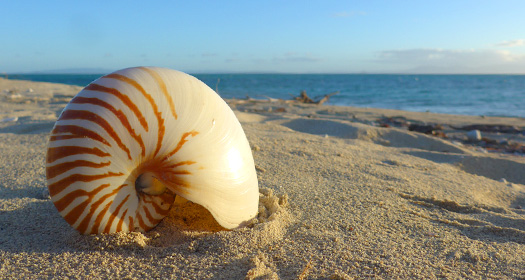
|
June 13, 2018 (Day 4,031)
Quick Fix: 13° 29.4 S / 143° 43.3 E
Conditions: Wind: 12/SE Sky: Clear

Final Ascent
With a strong wind forecast for next week, Dream Time is making a push for the summit - 'the tip' - Australia's most northern protrusion. We're at latitude thirteen south and for the last few days we've sailed along a barren and lonely coastline that, strangely, feels more remote than even the Tuamotus. There are no towns this far north, just a few isolated Aboriginal communities and dusty airstrips. We're also deep in crocodile territory so we're choosing to anchor away from the mainland and behind sandy cayes that dot the Great Reef. Help, should you need it out here, could be days away, but in the 1800's it would've be months or perhaps years, so mariners planted coconut trees and deposited goats ashore to support ill-fated castaways. An unmarked grave rests under the shade of one of the few remaining palms on Morris Island, a pearl diver that never made it home. We found a nautilus shell. The goats have long gone. |
|

|
 |

|

| June 9, 2018 | Lizard Island, Great Barrier Reef - Saturday beach hopping with nary a tourist in sight. |
|

| June 9, 2018 | Lizard Island, Great Barrier Reef - Searching for blacktip sharks and turtles at low tide. |
|

| June 8, 2018 | Lizard Island, Great Barrier Reef - A happy Neville catching tradewinds in the Blue Lagoon. |
|

|
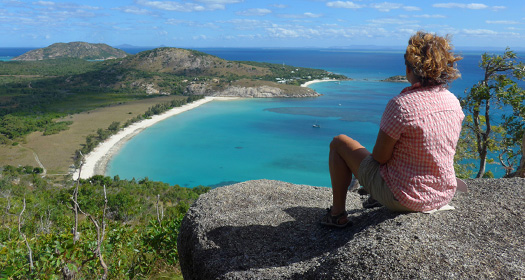
|
June 6, 2018 (Day 4,024)
Quick Fix: 14° 39.6 S / 145° 26.9 E
Conditions: Wind: 18/SE Sky: Clear

A View From Jiigurru
Dream Time set sail from Cooktown, her twisted bow pointing vaguely northeast towards a tiny cluster of islands ten miles from the outer reef. Jiigurru, meaning a place of initiation, was named by the local Dingaal people thousands of years before Cook entered these waters and long before rising sea levels flooded the coastal plains, converting the mountain peak into today's island group. During Cook's visit the only thing he sighted here, other than a safe passage through the reef, were lizards, so to European settlers Jiigurru became known as Lizard Island. Today, rather than hosting ancient Aboriginal ceremonies, the island's swanky resort welcomes affluent tourists from around the world. We hiked to the summit and stood where Cook trained his spyglass across the horizon discovering his exit - we discovered a WiFi signal and downloaded emails from New York, Tahiti, weather files and satellite images - so much has changed in just two hundred years, except the view. |
|

|
 |

|

| June 4, 2018 | Lizard Island - Upon seeing the extent of reef from his high vantage point, Cook confided in his diary to be, "altogether at a loss which way to steer." |
|

|
| |

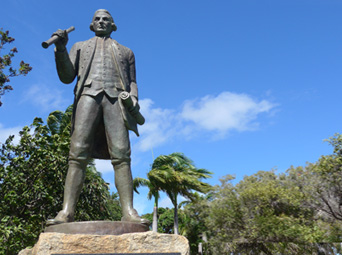
|
|
|
 |
Day 4,020 - Cooktown, Australia
19:31hrs - June 2, 2018
Cooktown Repairs |

I'm no Captain Cook crusader, but there is something pretty cool, for a mariner at least, to be sailing along his historic wake up the northeastern coastline of Australia, during the same winter months, in similar accelerated tradewind conditions, whilst visiting the very same windswept anchorages.
Our Captain Cook tribute tour continues: Over the last few weeks we've sailed past the very reef that ensnared the Endeavour 248 years ago, a gnarly piece of surf swept coral that held his ship captive for twenty-three terrifying hours, very nearly costing Cook his command and his crew (and Australia its British heritage). Just five miles from the famous reef we anchored at Hope Islands, named by Cook who expressed a great desire to reach the sandy cays in the hope of finding refuge for his stricken ship. And last week, sailing along an arid and uninhabited coastline that has essentially remained unchanged since Captain Cook scanned it with his spyglass in 1770, Dream Time entered a shallow muddy river entrance, dropped the hook in a narrow channel, swung with the ebbing current and promptly ran aground.
After dumping fifty tons of ballast, essential gear, cannons, even precious water casks, food stores and a spare anchor, Endeavour floated free from the reef and, with a sticky sail slung under her hull to slow the sinking, sailed north, desperately searching for a safe haven to make repairs. Cook found his refuge and intentionally beached the Endeavour on the very same crocodile infested river bed that Dream Time found herself perched, and although Endeavour would remain careened for 48 days for hull repairs, and Dream Time floated free with the tide after just an hour, in our own leisurely, chartplotter-autopilot-transducer-satellite assisted way, arriving in Cooktown felt like no less of an accomplishment.
With the rising tide Dream Time sailed over a central sandbar that separates the Endeavour River into two vague channels, and with the aid of a lead line from the dinghy - yep, old school just like Cook (and an iPad Navionic's chart) - we sounded and plotted a deeper channel before relocating to a snug anchorage between sand shoals and derelict boats.
Cooktown is the most northern outpost on Australia's eastern coastline and it has a distinct Wild West frontier town reputation. Gold was discovered nearby in 1872 and 15,000 prospectors, prostitutes and publicans flooded its shorelines in search of fortune bringing all the lawlessness and chaos one would expect. And until recently, Cooktown was only casually accessible by boaties or 4x4 truckers who were willing to venture off the tarmac. During 'the wet' summer months, before bitumen was laid between Cairns and Cooktown, the roads were all but impassible, and even today, with only 2,600 locals and a fully paved road leading south, Cooktown has managed to maintain a little of its perilous charm. And we like it here.
We've spent five days visiting all the main attractions: where Captain Cook first stepped ashore; the James Cook Museum where Cook's anchor and cannon - the very one's he tossed into the sea - can be viewed in an hermetically sealed glass room; we even hiked up Grassy Hill and stood on the same windy summit the great captain scanned the turquoise checkered horizon which gave him, "no small uneasiness" at the sheer number of reefs and shoals to negotiate.
We visited Top Pub, a popular watering hole where I sank a few schooners of Great Northern beer with locals, played a game of pool with Stan, a surveyor, and offered a little advice to local miners, twin brother who recently purchased an old sailboat for $8,000 that's been sitting in the river for seven years. The twins have epic plans to sail their new command to Hawaii later this year, and the fact that there's a foot of growth on the hull, a rich tapestry of mold in the cabin, and from engine to rigging almost every system, shackle and sheet needs to be replaced, hasn't dampened their adventurous spirits, well, it's enough to inspire Cook himself.
Strong winds forced Captain Cook to heave-to outside this river entrance for two days, and since our arrival it's been gusting to near-gale strength. Holding is of the highest quality so Dream Time hasn't dragged her anchor an inch, only swinging with the changing current every six hours, sketching a 'C' on our chartplotter display as though honoring the great captain. But on our third day a sailboat arrived and after swinging dangerously close to one of the derelict yachts in the late evening, decided to re-anchor in conditions that what would have even Cook himself at a loss - dark, 35 knot wind gusts, rain, a steady current and very limited room between sand bars and boats. The screams of communication between the traumatized couple onboard trying to navigate the situation had Dream Time's spreader lights on (spot lights illuminating the deck) and me on the bow clutching a fender.
Caught by current and wind and rapidly sweeping towards Dream Time, I heard instructions from the bow, "HARD TO PORT!", a response from the cockpit, "I AM HARD TO PORT!!" to which I decided to contribute, "YOU ARE NOT GOING TO MAKE IT - FULL THROTTLE!!!". The yacht had not anticipated the incoming current so within seconds they swept closer to our bow and with nothing to do but clutch my fender, I watched in horror as the yacht's stern rail grabbed our pulpit and, seemingly in slow motion, wrenched it into a gnarly mess. The sound of tearing metal vibrating through our hull had a wide-eyed Catherine running out of the cabin covered in soap wearing only a towel.
It was an unfortunate night, for sure, but if the yacht had collided with our hull or bowsprit, the damage would have been significantly worse and, like Cook, we would have found ourselves trapped on the river for much longer than we would have wanted. In preparation for our departure tomorrow we've twisted the pulpit away from our furler so we can continue to sail to Darwin, where we hope to make full repairs, we've redirected lifelines to add tension to the broken frame, and reinforced the twisted pulpit with line. We were lucky, not only does the damage appear to be limited to just stainless steel, but we were struck by two entirely reasonable, honest and altogether lovely people, who also happen to be barristers.
In just two weeks Cooktown celebrates the arrival of the Endeavour with a two-day festival complete with a fully costumed re-enactment of Cook's landing, musket volleys, cannon reports, and at Top Pub, a tug of war, mud crab races and a pie eating competition! We'd love to stay for this historic event but we've got a pulpit to fix, so it is time to raise sail and a few more latitudes.
The irony is not lost on us: Captain Cook sailed his damage ship into the Endeavour River to make repairs, we'll be leaving to make ours. |

|
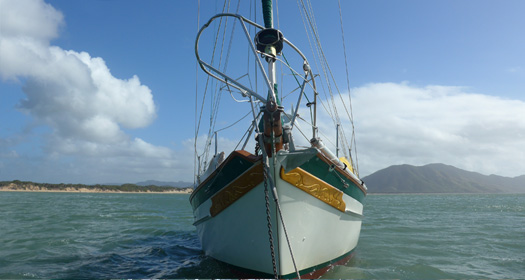
|
June 2, 2018 (Day 4,020)
Quick Fix: 15° 27.6 S / 145° 14.7 E
Conditions: Wind: 22/SE Sky: Mostly clear

A Crook Hook in Cook
It seems, for Dream Time at least, that the rather vague warning to tourists visiting Cooktown to "exercise reasonable caution" is not aimed at unruly locals, crocodiles lurking under murky river waters, or even the mosquitoes that tormented Captain Cook and his men 248 years ago, but rather it's the neighboring boats. Three days ago, on a particularly stormy night with rain squalls and 35 knot wind bullets, a local boat, whilst attempting to re-anchor, collided with Dream Time. The rogue yacht hooked our pulpit with its davits and, before releasing us, twisted it into a gnarly mess. We're lucky, really, as judging by the state of most of the boats anchored in Cooktown we were quite possibly rammed by the only yacht on the river that carries insurance! The couple were mortified at the carnage they caused. But it could have been a lot worse - no one was hurt and, hey, accidents happen, just ask Captain Cook. More to follow... |
|

|
 |

|

| June 1, 2018 | Cooktown - Captain Cook clutching his spyglass and hand drawn chart, searching for a way out of the labyrinth now known as the Great Barrier Reef. |
|
|
|

 |
|